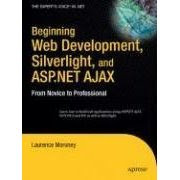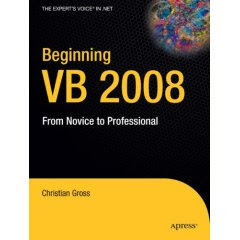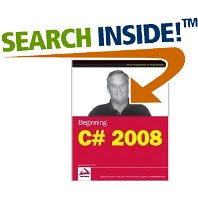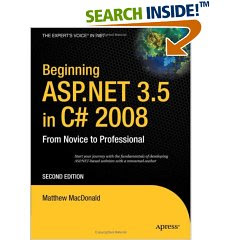
Paperback: 308 pages
Publisher: O'Reilly Media, Inc. (January 11, 2008)
Language: English
ISBN-10: 0596510500
ISBN-13: 978-0596510503
Product Dimensions: 9.1 x 7 x 0.9 inches
If you think you're well versed in ASP.NET, think again. This exceptional guide gives you a master class in site building with ASP.NET 3.5 and other cutting-edge Microsoft technologies. You learn how to develop rock-solid web portal applications that can withstand millions of hits every day while surviving scalability and security pressures -- not just for mass-consumer homepages, but also for dashboards that deliver powerful content aggregation for enterprises. Written by Omar AL Zabir, co-founder and CTO of Pageflakes, Building a Web 2.0 Portal with ASP.NET 3.5 demonstrates how to develop portals similar to My Yahoo!, iGoogle, and Pageflakes using ASP.NET 3.5, ASP.NET AJAX, Windows Workflow Foundation, LINQ and .NET 3.5. Through the course of the book, AL Zabir builds an open source Ajax-enabled portal prototype (available online at "www.dropthings.com"), and walks you though the design and architectural challenges, advanced Ajax concepts, performance optimization techniques, and server-side scalability problems involved. You learn how to: Implement a highly decoupled architecture following the popular n-tier, widget-based application model Provide drag-and-drop functionality, and use ASP.NET 3.5 to build the server-side part of the web layer Use LINQ to build the data access layer, and Windows Workflow Foundation to build the business layer as a collection of workflows Build client-side widgets using JavaScript for faster performance and better caching Get maximum performance out of the ASP.NET AJAX Framework for faster, more dynamic, and scalable sites Build a custom web service call handler to overcome shortcomings in ASP.NET AJAX 1.0 for asynchronous, transactional, cache-friendlyweb services Overcome JavaScript performance problems, and help the user interface load faster and be more responsive Solve scalability and security problems as your site grows from hundreds to millions of users Deploy and run a high-volume production site while solving software, hardware, hosting, and Internet infrastructure problems Building a Web 2.0 Portal with ASP.NET 3.5 also presents real-world ASP.NET challenges that the author has solved in building educational and enterprise portals, plus thirteen production disasters common to web applications serving millions of users. If you're ready to build state-of-the art, high-volume web applications, this book has exactly what you need.
User Review:Omar is an excellent .NET programmer and I really enjoyed his book. This book gave excellent insight on running a high volume website with ASP.NET. It also dives into some of the new features of the .NET 3.5 framework. I really enjoyed the sections towards the end where he showed the type of hosting environment necessary to run a large scale website. I would also recommend subscribing to Omar's RSS feeds for excellent tips.
This book explains the techniques behind the DropThings portal [...] showing some source-code (available at www.codeplex.com) and giving a couple of tips and tricks of web 2.0 programming. The book is very interesting but it's for those developers who already know the technologies it covers (ASP.NET, C#, LINQ, WF and ASP.NET AJAX) and want to know "the best way to do it" or became aware of commom problems that big web 2.0 portals generally has.
Below is the main topics of each chapter:
Chapter 1 - Conceptual meanings of Web and ASP.NET.
Chapter 2 - How can you design your own Widgets Framework (Based on his ideas that lead him to develop his own framework) and things that you need to concern when you develop a big portal.
Chapter 3 - Tips and Tricks of developing rich client controls
Chapter 4 - How can you add LINQ and Workflow Foundation to your Data and Business Layers.
Chapter 5 - Developing Widgets itself
Chapter 6, 7, 8 and 9 - Reflections over performance (at Client, Server and "client-server" interaction)
Chapter 10 - Solving Deployment and "Go-live" problems.
Bear in mind this book don't teach you those technologies, it only leads you to use them in a better way based on the author's experience (Author is the PageFlake's co-Founder and CTO, so he really knows what he's talking about).
In conclusion, if you want to learn how you use those technologies (Asp.net Ajax, Workflow Foundation..), I recommend you to try other books. Otherwise, if you want to know more about how to create a scalable web 2.0 site, tips & tricks and the best practices of those techs at web, this book will hit at the bullseye.
Free Download:























